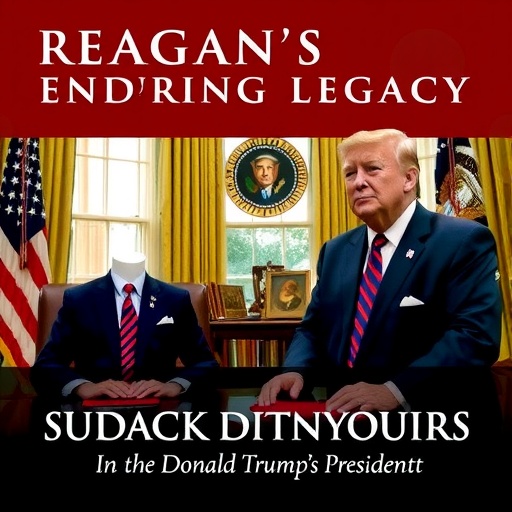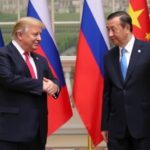Reagan’s Enduring Legacy: How Ronald Reagan Shapes Donald Trump’s Presidency in the Oval Office
In the hallowed halls of the Oval Office, where history whispers through every decision, President Donald Trump’s tenure bears an unmistakable imprint of Ronald Reagan‘s legacy. From bold economic overhauls to unapologetic nationalist rhetoric, Trump’s presidency echoes the Gipper’s playbook, influencing policies that define America’s global stance and domestic revival. This influence isn’t mere coincidence; Trump has openly invoked Reagan as a guiding light, blending the 40th president’s charisma and conservatism into his own disruptive style.
- Tax Cuts and Deregulation: Reaganomics Revived in Trump’s Agenda
- Rhetorical Fireworks: Trump’s Tweets Echo Reagan’s ‘Morning in America’
- Foreign Policy Parallels: Cold War Warriors to Trade Deal Titans
- Oval Office Tributes: Symbolic Gestures Honoring Reagan’s Presidency
- Future Horizons: Reagan’s Influence on Post-Trump American Politics
Tax Cuts and Deregulation: Reaganomics Revived in Trump’s Agenda
Ronald Reagan‘s economic revolution, often dubbed Reaganomics, promised supply-side prosperity through sweeping tax reductions and regulatory rollbacks. Fast-forward to 2017, and Donald Trump channeled this legacy directly into his first major legislative victory: the Tax Cuts and Jobs Act. Signed into law amid fervent Republican cheers, the bill slashed the corporate tax rate from 35% to 21%, mirroring Reagan’s 1981 Economic Recovery Tax Act that dropped the top individual rate from 70% to 50%. Economists like Arthur Laffer, whose famous curve inspired Reagan, praised Trump’s move as a ‘Reaganite revival,’ noting in a 2018 Wall Street Journal op-ed that it could ignite similar growth spurts seen in the 1980s.
Statistics underscore the parallels. Under Reagan, GDP growth averaged 3.5% annually from 1983 to 1989, fueled by deregulation in industries like airlines and telecommunications. Trump’s administration, building on this foundation, eliminated over 20,000 pages of federal regulations by 2020, according to the White House’s own tally. This deregulation frenzy targeted environmental rules and financial oversight, echoing Reagan’s assault on the ‘administrative state.’ Trump’s economic team, including advisors like Larry Kudlow—a former Reagan speechwriter—explicitly drew from these playbooks. Kudlow once remarked in a CNBC interview, ‘President Trump is finishing what Reagan started: unleashing American enterprise.’
Yet, the influence extends beyond policy mechanics. Reagan’s optimism about free markets resonated in Trump’s Oval Office addresses, where he touted the stock market’s record highs as proof of his ‘America First’ prosperity. By 2019, the Dow Jones had surged 50% since Trump’s inauguration, a boom reminiscent of Reagan-era bull markets. Critics, however, point to rising deficits—ballooning to $3.1 trillion under Trump by 2020, per Congressional Budget Office data—as a Reagan-like flaw, where tax cuts outpaced spending restraint. Still, for Trump supporters, this legacy cements his presidency as a continuation of Reagan’s vision for a leaner, wealthier America.
Rhetorical Fireworks: Trump’s Tweets Echo Reagan’s ‘Morning in America’
Ronald Reagan wasn’t just a policymaker; he was a communicator extraordinaire, turning complex ideas into folksy, memorable soundbites. His 1984 ‘Morning in America’ campaign ad painted a picture of national renewal that propelled him to a landslide reelection. Donald Trump, master of the modern megaphone via Twitter, has adopted a similar flair for dramatic, optimistic nationalism. From declaring ‘Make America Great Again’—a phrase Reagan used in 1980—to railing against ‘fake news’ media, Trump’s style borrows heavily from the Gipper’s anti-establishment zest.
Historians like H.W. Brands, author of ‘Reagan: The Life,’ have noted in interviews with Politico that Trump’s bombastic tweets serve as digital equivalents of Reagan’s radio addresses. Reagan’s weekly broadcasts from the Oval Office humanized the presidency, much like Trump’s late-night posts rally his base. A 2019 study by the Pew Research Center found that 70% of Republicans viewed Trump as a strong leader akin to Reagan, citing his direct communication as a key similarity. Trump’s invocation of Reagan peaked during his 2016 campaign, where he hung a Reagan portrait in his jet and quipped at rallies, ‘Reagan proved you can win without the elites.’
This rhetorical legacy shapes public perception profoundly. Reagan’s approval ratings hovered above 60% for much of his second term, per Gallup polls, buoyed by his avuncular charm. Trump, facing volatility—dipping to 38% in 2020 amid impeachment trials—nonetheless maintained a loyal core by emulating Reagan’s defiance. Quotes from Trump’s speeches abound with Reagan echoes: In a 2017 address to Congress, he spoke of ‘restoring the promise of America,’ a direct nod to Reagan’s 1981 inaugural. Communication experts argue this isn’t accidental; Trump’s speechwriters, influenced by Reagan-era veterans, craft messages that blend populism with presidential gravitas.
Beyond tweets, the Oval Office itself becomes a stage. Trump rearranged the furniture to evoke Reagan’s setup, including the Resolute Desk where the Gipper signed landmark bills. This symbolic continuity reinforces Trump’s narrative as Reagan’s heir, turning every policy announcement into a legacy-affirming event.
Foreign Policy Parallels: Cold War Warriors to Trade Deal Titans
Ronald Reagan’s foreign policy legacy is etched in the fall of the Berlin Wall, achieved through a blend of military buildup and diplomatic brinkmanship. He labeled the Soviet Union an ‘evil empire’ and boosted defense spending by 40% in real terms, per Defense Department records, forcing concessions that ended the Cold War. Donald Trump, navigating a multipolar world, has mirrored this assertive posture, pivoting from alliances to ‘America First’ deals that prioritize U.S. interests.
Take the U.S.-Mexico-Canada Agreement (USMCA), Trump’s 2018 renegotiation of NAFTA. Echoing Reagan’s protectionist tariffs on Japanese imports in the 1980s, USMCA included stricter labor rules and digital trade provisions, hailed by the U.S. Chamber of Commerce as a ‘Reagan-style win for workers.’ Trump’s trade war with China, imposing $360 billion in tariffs by 2019, recalls Reagan’s tough stance on unfair competition. As former National Security Advisor John Bolton wrote in his memoir, Trump often referenced Reagan’s ‘peace through strength’ doctrine during Oval Office strategy sessions.
Immigration policy offers another stark parallel. Reagan’s 1986 Immigration Reform and Control Act granted amnesty to 3 million undocumented workers while bolstering border security—a balanced approach Trump adapted with his border wall push and asylum restrictions. Though amnesty eluded Trump, his rhetoric of ‘building the wall’ evoked Reagan’s 1987 Berlin plea: ‘Mr. Gorbachev, tear down this wall!’ Public opinion polls from Quinnipiac in 2019 showed 55% of voters saw Trump’s foreign policy as Reagan-inspired toughness, particularly in withdrawing from the Iran nuclear deal and Paris climate accord, moves Reagan might have endorsed given his skepticism of multilateralism.
Challenges abound, however. Reagan’s legacy includes fostering NATO’s expansion, which Trump critiqued as outdated, demanding allies pay more—a friction point that strained alliances. Yet, in the Oval Office, Trump’s decisions like the Abraham Accords in 2020, normalizing Israel-Arab ties, project Reagan-esque diplomatic triumphs, reshaping Middle East dynamics without endless wars.
Oval Office Tributes: Symbolic Gestures Honoring Reagan’s Presidency
The Oval Office isn’t just a workspace; it’s a repository of presidential symbolism. Donald Trump transformed it into a shrine to Ronald Reagan’s legacy, displaying busts and photos that underscore his admiration. Upon entering in 2017, Trump requested Reagan’s portrait join those of Lincoln and Washington, stating in a Fox News interview, ‘Reagan was the greatest, and his ideas are what made America strong.’ This visual homage influences daily deliberations, reminding aides of the conservative principles that defined the 1980s.
Events in the Oval Office amplify this. Trump’s signing of the First Step Act in 2018, a bipartisan criminal justice reform, drew Reagan comparisons for its focus on second chances, akin to the Gipper’s 1988 anti-drug initiatives. White House logs reveal frequent Reagan film screenings for staff, fostering a cultural echo chamber. Political analysts like Fred Barnes, in his book ‘Will the Real Trump Please Stand Up?’, argue these gestures shape Trump’s decision-making, from Supreme Court picks—nominating conservatives like Gorsuch, echoing Reagan’s Scalia—to environmental rollbacks that undo Obama-era rules Reagan would have decried as overreach.
Public perception ties into this symbolism. A 2020 Rasmussen poll indicated 62% of Republicans believed Trump’s presidency extended Reagan’s legacy, boosted by Oval Office optics like hosting Reagan family members. Nancy Reagan’s 2016 funeral attendance by Trump signaled endorsement, further cementing the link. These tributes aren’t superficial; they guide policy, ensuring Trump’s Oval Office tenure aligns with Reagan’s blueprint for enduring conservatism.
As Trump’s presidency unfolded, Reagan’s shadow loomed large in crises. During the 2020 COVID-19 response, Trump’s calls for rapid economic reopening mirrored Reagan’s handling of the 1981-82 recession, prioritizing recovery over caution. Though outcomes differed—Reagan’s unemployment peaked at 10.8%, Trump’s at 14.8%—the Oval Office resolve remained Reaganian: optimistic, resolute, and legacy-driven.
Future Horizons: Reagan’s Influence on Post-Trump American Politics
Looking ahead, Ronald Reagan’s legacy through Donald Trump’s presidency promises to ripple into future Oval Office occupants. As the Republican Party evolves, Trump’s fusion of Reaganomics with populist fervor could redefine conservatism, influencing 2024 contenders like Ron DeSantis, who cites both leaders in his Florida governance. Policy think tanks, such as the Heritage Foundation—architects of Reagan’s agenda—project that Trump’s tax framework may endure, with potential extensions eyed by Congress to sustain growth amid inflation fears.
Globally, the assertive foreign policy stance may normalize ‘America First’ diplomacy, challenging multilateral norms Reagan helped build but Trump remolded. Historians predict this legacy will be debated in textbooks, with Trump’s Oval Office innovations— from social media diplomacy to deregulatory zeal—credited to Reagan’s foundational influence. As Biden’s administration grapples with reversals, the Gipper’s shadow ensures Trump’s presidency isn’t an aberration but a chapter in an ongoing conservative saga. Whether fostering unity or division, Reagan’s enduring impact guarantees his ideas will shape the presidency for generations, urging leaders to dream big and act boldly from the Oval Office desk.








